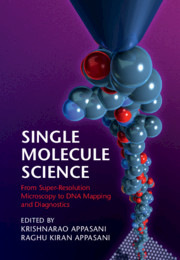Book contents
- Single-Molecule Science
- Single-Molecule Science
- Copyright page
- Dedication
- Contents
- Contributors
- Foreword
- Preface
- Part I Super-Resolution Microscopy and Molecular Imaging Techniques to Probe Biology
- 1 Introduction on Single-Molecule Science
- 2 One Molecule, Two Molecules, Red Molecules, Blue Molecules
- 3 Multiscale Fluorescence Imaging
- 4 Long-Read Single-Molecule Optical Maps
- Part II Protein Folding, Structure, Confirmation, and Dynamics
- Part III Mapping DNA Molecules at the Single-Molecule Level
- Part IV Single-Molecule Biology to Study Gene Expression
- Index
- References
2 - One Molecule, Two Molecules, Red Molecules, Blue Molecules
Methods for Quantifying Localization Microscopy Data
from Part I - Super-Resolution Microscopy and Molecular Imaging Techniques to Probe Biology
Published online by Cambridge University Press: 05 May 2022
- Single-Molecule Science
- Single-Molecule Science
- Copyright page
- Dedication
- Contents
- Contributors
- Foreword
- Preface
- Part I Super-Resolution Microscopy and Molecular Imaging Techniques to Probe Biology
- 1 Introduction on Single-Molecule Science
- 2 One Molecule, Two Molecules, Red Molecules, Blue Molecules
- 3 Multiscale Fluorescence Imaging
- 4 Long-Read Single-Molecule Optical Maps
- Part II Protein Folding, Structure, Confirmation, and Dynamics
- Part III Mapping DNA Molecules at the Single-Molecule Level
- Part IV Single-Molecule Biology to Study Gene Expression
- Index
- References
Summary
Improvement of super-resolution microscopy in the last decade has led to the development of methods such as stimulated emission depletion (STED) microscopy and structured illumination microscopy (SIM), which modulate the excitation light to break the diffraction limit, or methods such as photo-activated localization microscopy (PALM) or stochastic optical reconstruction microscopy (STORM), which utilize the photoswitching properties of fluorescent molecules to enable precise localization of single molecules (Patterson, 2009). In this chapter, we will focus on PALM/STORM methods, which rely on similar principles and instrumentation. Namely, these acquire a series of images of fields of single molecules followed by subsequent image analysis to localize the molecules to much higher precision than their diffraction limited signals. Importantly, thousands or millions of molecules are identified and used to reconstruct the super-resolution images (Betzig et al., 2006; Hess et al., 2006; Rust et al., 2006; Heilemann et al., 2008; van de Linde et al., 2009; Kamiyama and Huang, 2012).
- Type
- Chapter
- Information
- Single-Molecule ScienceFrom Super-Resolution Microscopy to DNA Mapping and Diagnostics, pp. 20 - 37Publisher: Cambridge University PressPrint publication year: 2022

